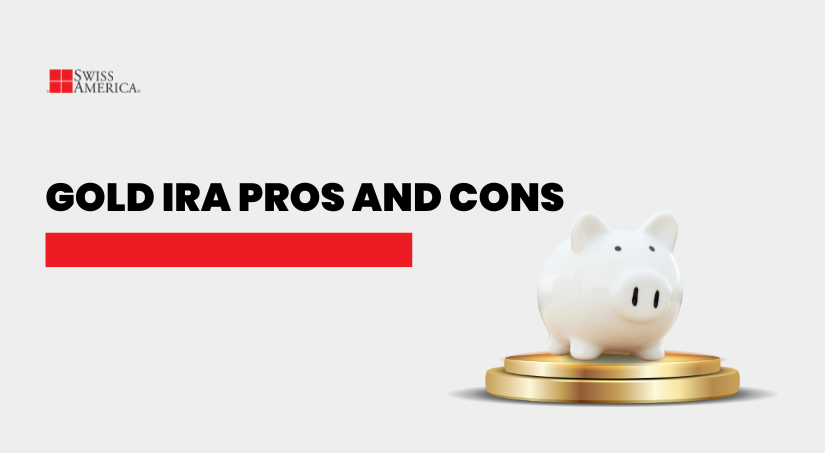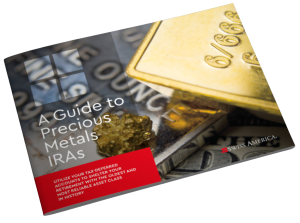
Gold recently hit $3,600/oz and is up over 41% over the last year. That has more people weighing the Gold IRA pros and cons as they think about buying precious metals with their retirement savings.
Here’s what you should know about how these accounts work and if they make sense for you.
What is a Gold IRA?
A Gold or Precious Metals IRA means the same thing. It’s a Self-Directed IRA retirement account that enables you to invest in physical precious metals. They work just like a traditional IRA in terms of IRS contribution limits, tax advantages, and overall rules for retirement funds. This is not the same as investing in paper gold and silver assets like ETFs or mutual funds.
Gold IRA pros and cons
The pros of using your IRA to hold physical gold or other precious metals include:
| Pros | Cons |
| Tax benefits of traditional or Roth IRAs | No income generation |
| Protects against inflation | IRS rules and storage restrictions |
| Tangible assets | Higher account fees than standard IRAs |
| Diversifies retirement savings | Investment minimums |
| Easy rollover from other retirement plans | Limited choices for approved metals |
| More control over your investments | Can be more complex to set up |
| Simple to sell gold when needed | Risk of scams and counterfeit products |
Pros
Some of the main benefits of gold investing with a Self-Directed IRA include:
Gold IRAs have tax advantages
A Gold IRA gives you the same tax benefits as a traditional or Roth IRA. If you have a traditional IRA, you add pre-tax dollars to your account, and your gold grows tax-deferred. You won’t pay taxes until you take the money out later. Putting money in also lowers your taxable income for the year.
For 2026, you can add up to $7,500 if you’re under 50, or $8,600 if you’re 50 or older.
With a Roth Gold IRA, you use after-tax dollars. Your gold grows tax-free, and when you take it out in retirement, you don’t owe taxes on it. The same contribution limits apply, but the IRS has income limits that can affect how much you can put in your retirement nest egg.
Gold IRAs protect against inflation
The problem with paper money is that the government can always print more, so every dollar becomes worth less. Gold protects against inflation because there’s only so much of it in the world. It’s also completely independent of the U.S. dollar. If we look at gold vs. inflation ever since 1974, when President Ford made it legal to own gold again, it’s outpaced inflation by about 77%.
Gold IRAs give you real assets
When you own gold or other precious metals, you’re holding physical assets. They don’t depend on markets and systems, and their value doesn’t disappear because of a glitch or a bad quarter. Many investors like the peace of mind that comes from reducing risk and owning tangible assets you can actually touch.
Gold IRAs diversify your savings
Adding physical gold or other precious metals to your retirement savings gives you a way to reduce the impact of stock market volatility. Gold and silver tend to perform well during times of crisis or economic uncertainty. So, while the stock market reacts to bad news, precious metals give you a way to balance that out and protect your wealth.
Gold IRA rollovers are easy
You can roll over money from an existing retirement account without IRS penalties. For example, if you have a 401(k) with a past employer, you can move those funds into a Gold IRA and add physical gold to your retirement savings. This gives you more control over your account while keeping your money tax-advantaged. Eligible accounts for a Precious Metals or Gold IRA rollover include:
- Traditional IRA
- Roth IRA
- Simple IRA
- 401(k)
- 403(b)
- 457 Plan
- TSP
Gold IRAs give you more control
A Precious Metals or Gold IRA gives you more control over investments in your retirement account. Instead of being locked into the usual mix of paper assets, you can add tangible assets that can reduce risks. This lets you put together your retirement portfolio the way you want.
Gold IRAs are easy to sell
The physical gold investments you hold inside a Precious Metals IRA are easy to sell. When it’s time to withdraw funds from your retirement account, you can easily sell gold back to your dealer or other Gold IRA companies.
Cons
Drawbacks of adding physical gold investments to your self-directed retirement savings include:
Gold and silver don’t generate income
Gold doesn’t give you yields, dividends, or passive income like some traditional investments can. Incorporating physical gold is more of a defensive strategy to protect your money, but that comes with a trade-off. That’s why your financial advisor might recommend that you put a portion of your savings, like 5%-10% into gold or other precious metals.
Potential for IRS penalties
The IRS has rules around which metals qualify. This is different than a traditional IRA, where you can buy any paper assets you want. Also, you can’t store your precious metals at home, which isn’t really a consideration with assets like mutual funds or stocks.
Gold IRAs have investment minimums
Most Gold IRA companies have a minimum investment to get started with a Precious Metals IRA. For example, Swiss America’s minimum is $5,000. This is different than a traditional individual retirement account, where you can start with less.
Limited precious metals options
The approved metals products list limits the options for precious metal coins and bars. For example, you can’t buy collectible coins in your Gold IRA account. Instead, you’ll need to stick with investment bullion bars or coins from approved mints or manufacturers.
Gold IRAs are more complex
Many people aren’t familiar with how Gold IRAs work, which can make it a little complex to get started. Working with established Gold IRA companies can help you understand the overall process and how to fit self-directed gold and silver assets into your retirement plan.
Gold IRAs have higher fees
Gold IRAs have higher main account fees than a traditional IRA. Note that these aren’t the same as investment fees that individual assets carry. The higher costs are due to storage fees for your precious metals plus dealer premiums over spot price.
Risk of Gold IRA scams
Just like other investments, precious metals carry risk of scams and shady companies trying to sell you counterfeit metals. Be sure to work with a dealer that’s been in business for decades and has great customer reviews before putting any of your retirement funds into a Self-Directed Gold IRA.
How to set up a Gold IRA
You can set up your individual retirement account to hold gold with these three simple steps:
Step 1: Choose a precious metals custodian
You’ll need an IRA custodian to manage your account. Their role is to keep your account compliant, report to the IRS, and arrange for storage of your metals. Look at a few options, check out their fees, and customer reviews.
Open an account by completing paperwork and paying the initial setup fee.
Step 2: Fund your Self-Directed Gold IRA
The next step is to fund your account. You can do this by rolling over an old employer plan like a 401(k) or by using other funds to start a new IRA. If you are rolling over, call your existing plan administrator and have them send your funds directly to your Gold IRA custodian. This is the best way to avoid tax penalties and complications during the rollover.
Step 3: Buy and store gold
Work with your precious metals dealer to decide which gold, silver, platinum, or palladium physical holdings you want in your retirement portfolio. Once you decide, the precious metals custodian buys the metals on your behalf and arranges for secure storage in an IRS-approved depository.
The only thing you need to do from here is monitor your account, see what’s happening with gold prices, and rebalance if needed.
Taking withdrawals from a Gold IRA
At some point, you’ll want to take withdrawals from your Self-Directed IRA. This could be because you reach the retirement age of 59.5 or because you need to take IRS-required minimum distributions. There’s a few ways you can withdraw:
- In-kind: Your custodian can send you the physical gold held in your account. They’ll ship the metals to you. If you have a traditional IRA with tax-deferred growth, the IRS taxes you at current income tax rates on the metals you receive.
- Cash out: You can direct your custodian to sell your gold investments and receive funds after the sale, which the IRS taxes at that time.
Is a Gold IRA right for you?
Does a Precious Metals IRA make sense for your retirement portfolio? If you want to own tangible assets that can reduce risks from the stock market volatility, investing in a Gold IRA can be a good move. There are trade-offs, and only you can decide if the advantages outweigh these.
Want to find out if a Precious Metals IRA is the right move? Reach out to the Swiss America team and grab your free Gold IRA kit today.
Gold IRA pros and cons: FAQs
Is a Gold IRA better than a Roth IRA?
A Gold IRA and a Roth IRA can actually work together. A Roth grows tax-free, and a Gold IRA lets you hold physical metals for protection and diversification. With a Roth Gold IRA, you get both benefits in one account.
How much money do I need to start a Gold IRA?
The minimum to open a Precious Metals IRA is usually between $5,000 and $10,000, and with Swiss America, you can get started with just $5,000.
Is it better to buy physical gold or a Gold IRA?
If you want to own physical gold, you can buy it outright anytime. A Gold IRA does the same thing, but inside a retirement account, so you also get the tax benefits.
The information in this post is for informational purposes only and should not be considered tax or legal advice. Please consult with your own tax professionals before making any decisions or taking action based on this information.
